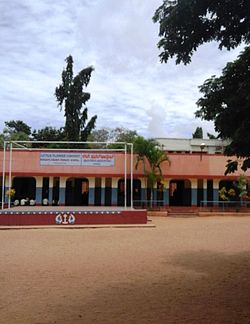T.Narsipur
|
Tirumakudal Narsipur ಟಿ.ನರಸೀಪುರ T.N.Pura |
|
|---|---|
| City | |

Little Flower School, T.Narasipur
|
|
| Nickname(s): Temple City | |
| Coordinates: 12°12′36″N 76°54′22″E / 12.21°N 76.906°ECoordinates: 12°12′36″N 76°54′22″E / 12.21°N 76.906°E | |
| Country |
|
| State | Karnataka |
| District | Mysore |
| Elevation | 638 m (2,093 ft) |
| Population | |
| • Total | 9,930 |
| Languages | |
| • Official | Kannada |
| Time zone | IST (UTC+5:30) |
| PIN | 571 124 |
| Telephone code | 08227 |
| Vehicle registration | KA-55 |
| Website |
[<span%20class="url"> |
Tirumakudalu Narasipura (Tirumakūḍalu Narasīpura) the temple city of Karnataka, commonly known as T. Narasipura or T.N. Pura, is a panchayat town in Mysore district in the Indian state of Karnataka. The first name refers to the land at the confluence, (trimakuta in Sanskrit(citation needed) at the confluence of the Kaveri, Kabini and Spatika Sarovara (a mythical lake or spring, also named Gupta Gamini). This is the place in South India where Kumbhamela is held every three years. It finds a mention in the Skanda Purana as one of the Trimakuta Kshetras (holy places at the confluence of three rivers). The word 'Narasipura' is the name of the town, which is derived from the famous Gunja Narasimhaswamy temple that is located on the right bank of the Kabini river. Considered as sacred as Prayag (confluence of the Ganges, the Yamuna and the Saraswati at Prayag – Varanasi - Kashi in North India), it is also known as Dakshina Kashi The town finds mention in tourism guides, both as a tourist place and a pilgrimage centre.
It is said that Tirumakudalu is where Rishi Agasthiya had visualised it as 'Dakshina Kashi' long ago. When he travelled down South to Narsipura, the town was a thick forest. Enamoured by the confluence of the three rivers - Kaveri, Kapila and the undercurrent of Spatika Sarovara - he wanted to install a Shiva Linga there and asked Hanuman to get him a linga from Kashi. Since the auspicious period lasting three-and-a-three-fourth of a galige was fast approaching and Hanuman failed to get the linga on time, the sage created a sand linga himself and consecrated it. An insulted Hanuman, who returned soon, cut off the top portion of the sand linga consecrated by Agasthya. Ever since this incident a perennial presence of water which is believed to be the water of Ganga can be found in the axed summit of the linga, and the same is offered as thirtha (holy water) to the pilgrims. The linga that Hanuman brought was consecrated a little distance away and is called the Hanuman Linga.
...
Wikipedia
